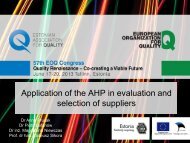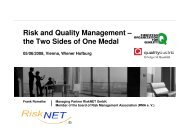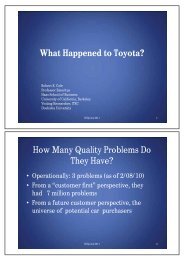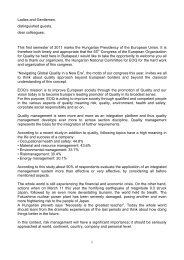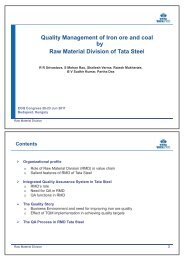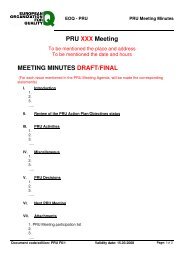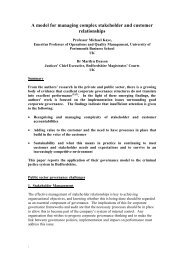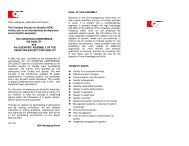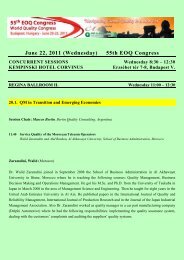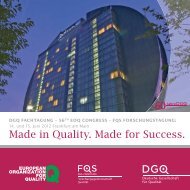How to Measure the Quality of Top Management-Mico Jancev - EOQ
How to Measure the Quality of Top Management-Mico Jancev - EOQ
How to Measure the Quality of Top Management-Mico Jancev - EOQ
You also want an ePaper? Increase the reach of your titles
YUMPU automatically turns print PDFs into web optimized ePapers that Google loves.
Jančev Mičo<br />
<strong>How</strong> <strong>to</strong> measure <strong>the</strong> <strong>Quality</strong> <strong>of</strong> <strong>Top</strong> management<br />
Jančev M.<br />
SMILE IT Solutions <strong>Jancev</strong> KG, Vienna, Austria/ Bosnia & Herzegovina <strong>Quality</strong> Association<br />
Abstract:<br />
There are numerous examples <strong>of</strong> use <strong>of</strong> <strong>the</strong> word “management”, which creates some confusion in <strong>the</strong> heads <strong>of</strong><br />
not a small number <strong>of</strong> people. The problem is not <strong>of</strong> a purely linguistic nei<strong>the</strong>r <strong>of</strong> a ”local” nature – it is about<br />
understanding <strong>of</strong> <strong>the</strong>ir content and <strong>the</strong> basic meaning. In <strong>the</strong> ISO 9000:2005 standard <strong>the</strong> term “management”<br />
refers <strong>to</strong> “coordinated activities <strong>to</strong> direct and control an organization”. In English, <strong>the</strong> term “management”<br />
sometimes refers <strong>to</strong> people, i.e. a person or group <strong>of</strong> people with authority and responsibility for <strong>the</strong> conduct and<br />
control <strong>of</strong> an organization. The role <strong>of</strong> <strong>to</strong>p management in <strong>the</strong> process <strong>of</strong> introduction <strong>of</strong> a <strong>Quality</strong> <strong>Management</strong><br />
System is very important. On account <strong>of</strong> that, <strong>the</strong> logical question is: <strong>How</strong> <strong>to</strong> measure <strong>the</strong> quality <strong>of</strong> <strong>the</strong> <strong>to</strong>p<br />
management? The answer, that <strong>the</strong> author suggests, could be found in an indirect way. The aim <strong>of</strong> this paper is<br />
<strong>to</strong> make a useful contribution <strong>to</strong> that direction <strong>of</strong> research.<br />
Key words:<br />
<strong>Management</strong>, <strong>Quality</strong> <strong>Management</strong>, Total <strong>Quality</strong> <strong>Management</strong>, ISO 9000 Standard, Audit, Decision,<br />
Knowledge<br />
1. INTRODUCTION<br />
If you continue <strong>to</strong> do <strong>the</strong> things that you have always done, you will continue <strong>to</strong> get<br />
what you have always got!<br />
<strong>Quality</strong> has certainly been a foundation s<strong>to</strong>ne for success <strong>of</strong> any organisation. It is <strong>the</strong> key <strong>to</strong> competitiveness in<br />
<strong>the</strong> open markets and has become a fundamental way <strong>of</strong> managing any business anywhere for achieving market<br />
growth and pr<strong>of</strong>itability. The nature <strong>of</strong> global business <strong>to</strong>day emphasises <strong>the</strong> need for organisations <strong>to</strong> be<br />
committed <strong>to</strong> a <strong>to</strong>tal quality management (TQM) approach. In particular, TQM strives <strong>to</strong> create a culture, which<br />
supports (is conducive <strong>to</strong> continuous) quality improvements throughout <strong>the</strong> organisation. [19]<br />
<strong>Management</strong>, Business <strong>Management</strong>, <strong>Quality</strong> <strong>Management</strong>, Total <strong>Quality</strong> <strong>Management</strong>… There are numerous<br />
examples <strong>of</strong> use <strong>of</strong> <strong>the</strong> word “management”, which creates some confusion in <strong>the</strong> heads <strong>of</strong> not a small number<br />
<strong>of</strong> people. It is not simply a question <strong>of</strong> terminology – it is much more important than that. The problem is not <strong>of</strong><br />
purely linguistic nature – it is about understanding <strong>of</strong> <strong>the</strong>ir content and <strong>the</strong> basic meaning. [9;10;23]<br />
In <strong>the</strong> ISO 9000:2005 standard <strong>the</strong> term “management” refers <strong>to</strong> “coordinated activities <strong>to</strong> direct and control an<br />
organization” (ISO 9000:2005, 3.2.6). In English, <strong>the</strong> term “management” sometimes refers <strong>to</strong> people, i.e. a<br />
person or group <strong>of</strong> people with authority and responsibility for <strong>the</strong> conduct and control <strong>of</strong> an organization. When<br />
it is used in this sense, <strong>to</strong> avoid confusion with <strong>the</strong> concept “management” defined above, it should always be<br />
used with some form <strong>of</strong> qualifier, for example “<strong>to</strong>p management” as “a person or group <strong>of</strong> people who directs<br />
and controls an organization at <strong>the</strong> highest level” (ISO 9000:2005, 3.2.7). The purpose <strong>of</strong> a <strong>Quality</strong><br />
<strong>Management</strong> System is <strong>to</strong> help achieving objectives – it must not, itself, become <strong>the</strong> objective. <strong>Top</strong> management<br />
has <strong>to</strong> concentrate on <strong>the</strong> results, because without <strong>the</strong>ir firm commitment <strong>to</strong> quality all efforts are bound <strong>to</strong> fail.<br />
Therefore in <strong>the</strong> ISO 9001 standard one <strong>of</strong> <strong>the</strong> most used phrases is: “<strong>Top</strong> management shall ensure (review,<br />
provide evidence, determine) that …” But, at <strong>the</strong> same time, <strong>the</strong> term “quality” is never mention in <strong>the</strong> <strong>Quality</strong><br />
<strong>Management</strong> principles in <strong>the</strong> same standard. [3]<br />
Evidently, <strong>the</strong> role <strong>of</strong> <strong>to</strong>p management in <strong>the</strong> process <strong>of</strong> introduction <strong>of</strong> a <strong>Quality</strong> <strong>Management</strong> System is very<br />
important. Because <strong>of</strong> that, <strong>the</strong> logical question is: <strong>How</strong> <strong>to</strong> measure <strong>the</strong> quality <strong>of</strong> <strong>the</strong> <strong>to</strong>p management? The<br />
answer could be found in an indirect way using <strong>the</strong> terminology and experience <strong>of</strong> <strong>the</strong> ISO 9000 standard. First<br />
<strong>of</strong> all, it is necessary <strong>to</strong> give an answer <strong>to</strong> <strong>the</strong> question: What are <strong>the</strong> key <strong>to</strong>p management’s products? In <strong>the</strong> ISO<br />
9001 standard is given clear and unequivocal interpretation <strong>of</strong> a this term: ”The term ’product’ applies only <strong>to</strong><br />
<strong>the</strong> product intended for, or required by, a cus<strong>to</strong>mer”. In my opinion, more creative application <strong>of</strong> <strong>the</strong> principle<br />
<strong>of</strong> “Process approach”, as well a definition <strong>of</strong> <strong>the</strong> term “product” as a “result <strong>of</strong> a process”, could help us <strong>to</strong><br />
find <strong>the</strong> answer <strong>to</strong> <strong>the</strong> question asked above.
2. QUALITY MOVEMENT: A LITLE HISTORY<br />
A modern quality his<strong>to</strong>ry did not begin with <strong>the</strong> appearance <strong>of</strong> <strong>the</strong> ISO 9000 standard. A miles<strong>to</strong>ne was 1915<br />
when Henry Ford invented <strong>the</strong> first assembly line. His manufacturing concept created a lot <strong>of</strong> new pr<strong>of</strong>essions,<br />
besides many o<strong>the</strong>r, a wide range <strong>of</strong> jobs which had <strong>to</strong> take care <strong>of</strong> quality: quality inspec<strong>to</strong>rs, quality planning<br />
engineers and a head <strong>of</strong> <strong>the</strong>m – a quality manager. This worked quite well, as long as all <strong>of</strong> <strong>the</strong> participants were<br />
organised <strong>to</strong> support a mass production in supplying <strong>the</strong> market. [2]<br />
Already in <strong>the</strong> sixties, <strong>the</strong> Japanese started <strong>to</strong> “irritate“ Western industry by coming up with products which were<br />
able <strong>to</strong> gain a significant market share in USA and Europe in different product areas, especially in <strong>the</strong><br />
au<strong>to</strong>motive industry. It <strong>to</strong>ok about 20 years until <strong>the</strong> leaders <strong>of</strong> Western corporates started <strong>to</strong> take this<br />
development seriously and <strong>to</strong> take a closer look at <strong>the</strong> way <strong>the</strong> Japanese operated <strong>the</strong>ir companies. The first<br />
serious step happened when <strong>the</strong>y began <strong>to</strong> introduce a documented <strong>Quality</strong> Assurance System in <strong>the</strong>ir fac<strong>to</strong>ries.<br />
In 1987 <strong>the</strong> Internal Organisation for Standardisation (ISO) launched <strong>the</strong> first comprehensive international<br />
<strong>Quality</strong> Standard. Besides <strong>the</strong> requirements for documenting how people in <strong>the</strong> company are trained <strong>to</strong> be able <strong>to</strong><br />
do <strong>the</strong>ir job, it was also quite new for most companies <strong>to</strong> introduce an internal audit system. To bring such a<br />
system <strong>to</strong> power and <strong>to</strong> live it up <strong>to</strong> <strong>the</strong> quality standards, it was necessary <strong>to</strong> have somebody <strong>of</strong>ficial <strong>to</strong> check.<br />
This created, mainly in Europe, a new service business: <strong>the</strong> certification business. [22]<br />
The intent <strong>of</strong> <strong>the</strong> 1987 and later <strong>the</strong> 1994 versions were clearly <strong>to</strong> create documented systems. Purpose <strong>of</strong> this<br />
systems was <strong>to</strong> assure cus<strong>to</strong>mer <strong>of</strong> product quality. In o<strong>the</strong>r words, it required <strong>the</strong> system <strong>to</strong> attain conformity<br />
with requirements. It is well known that <strong>the</strong> standards used <strong>to</strong> develop <strong>the</strong> original ISO 9000 series were born out<br />
<strong>of</strong> <strong>the</strong> defence industry where <strong>the</strong>re was a long tradition <strong>of</strong> command and control. As a consequence, ISO 9000<br />
followed <strong>the</strong> same pattern <strong>of</strong> imposing requirements <strong>to</strong> prevent failures despite <strong>the</strong> fact that experience has<br />
shown this method <strong>to</strong> be unsuccessful in ensuring good product quality. Looking at <strong>the</strong> internal aspects <strong>the</strong>re is<br />
no doubt that a certified quality system helps a lot <strong>to</strong> clarify tasks and <strong>the</strong> responsibilities thought <strong>the</strong> whole<br />
manufacturing process. But, <strong>the</strong> ISO 9000 was still only a described system and it could not be compared <strong>to</strong> what<br />
<strong>the</strong> Japanese has been doing. [3;22]<br />
The revised version <strong>of</strong> <strong>the</strong> ISO 9000:2000 series was released on 15 December 2000. The primary motivation for<br />
<strong>the</strong> changes has been <strong>to</strong> move organizations fur<strong>the</strong>r <strong>to</strong>wards business excellence, providing guidance that will<br />
enable <strong>the</strong>m <strong>to</strong> achieve sustained success. The ISO 9000:2000 series represents a fundamental change in intent,<br />
direction and approach. The 2000 version makes designing a quality management system a more complicated<br />
affair. There is no simple check list <strong>of</strong> 20 main requirements. The user is forced <strong>to</strong> stand back, analyse <strong>the</strong><br />
overall situation within <strong>the</strong> organization and <strong>to</strong> evaluate how <strong>the</strong> standard can serve it. In <strong>the</strong> o<strong>the</strong>rs words, <strong>the</strong><br />
essence <strong>of</strong> <strong>the</strong> ISO 9000:2000 series is a results-oriented approach <strong>to</strong> implementation in which <strong>the</strong> standard is not<br />
<strong>the</strong> objective, but <strong>the</strong> <strong>to</strong>ol <strong>to</strong> reach objectives. <strong>Quality</strong> management initiatives should now be based on eight<br />
<strong>Quality</strong> <strong>Management</strong> Principles that encapsulate <strong>the</strong> essence <strong>of</strong> good quality management. By looking at ISO<br />
9000 as a framework upon which a successful organization can be built, ra<strong>the</strong>r than as a narrow set <strong>of</strong> minimum<br />
requirements, significant benefits can be gained. [3;4]<br />
At <strong>the</strong> beginning <strong>of</strong> 1991, Juran identified eight lessons for effective way <strong>of</strong> achieving a quality revolution.<br />
These lessons were learnt from experience <strong>of</strong> American companies that have applied for <strong>the</strong> Malcolm Baldrige<br />
National <strong>Quality</strong> Award. They include matters such as <strong>to</strong>p management leadership, organization for quality<br />
improvement, recognition <strong>of</strong> quality in its wider sense, setting <strong>of</strong> quality goals and <strong>the</strong>ir incorporation in<strong>to</strong><br />
company business plans, cross-training (multiskilling), and delegation <strong>of</strong> authority. These lessons represent<br />
nei<strong>the</strong>r what Juran calls “a new strategy for Western countries“, nor a uniquely Japanese company wide quality<br />
control (CWQC). Ra<strong>the</strong>r, <strong>the</strong>y should be regarded as <strong>the</strong> essence <strong>of</strong> <strong>the</strong> genuine quality management. They are<br />
applicable anywhere in <strong>the</strong> world and were discovered through <strong>the</strong> intelligence and hard work <strong>of</strong> people from all<br />
kinds <strong>of</strong> management environments and cultural backgrounds. [1]<br />
In <strong>the</strong> closing address <strong>of</strong> <strong>the</strong> 51nd Annual <strong>Quality</strong> Congress <strong>of</strong> <strong>the</strong> American Society for <strong>Quality</strong> that was held in<br />
Philadelphia in 1998, Feigenbaum summarized <strong>the</strong> six fundamentals <strong>of</strong> <strong>to</strong>day’s vital signs <strong>of</strong> <strong>the</strong> quality<br />
development in <strong>the</strong> decade <strong>of</strong> 1990s. They are: (1) Remarkable human behavioural change in <strong>the</strong> way <strong>of</strong> thinking<br />
in how <strong>the</strong>y can improve <strong>the</strong> quality <strong>of</strong> <strong>the</strong> way <strong>the</strong>y work at <strong>the</strong>ir jobs and <strong>the</strong>y buy <strong>the</strong> products <strong>the</strong>y use; (2)<br />
<strong>Quality</strong> which has become one <strong>of</strong> <strong>the</strong> 20th Century's most important management ideas, (3) The new disciplines<br />
<strong>of</strong> quality cost economics; (4) <strong>Quality</strong> which has become an international business language; (5) Widespread
managerial recognition <strong>of</strong> <strong>the</strong> absolute and universal necessity for fact-based decision making; (6) Start<br />
measurement <strong>of</strong> <strong>the</strong> business results <strong>of</strong> quality in series and systematic terms. [1]<br />
The Evolution <strong>of</strong> <strong>Quality</strong> and <strong>Quality</strong> Organizations was a key issue during <strong>the</strong> first Global <strong>Quality</strong> Summit that<br />
<strong>to</strong>ok place in Antwerp, Belgium in May 2006. Delegates from <strong>the</strong> all parts <strong>of</strong> <strong>the</strong> world, were trying <strong>to</strong> find <strong>the</strong><br />
answers <strong>of</strong> <strong>the</strong> <strong>the</strong> following questions: What is <strong>the</strong> future <strong>of</strong> <strong>Quality</strong>? What is <strong>the</strong> future <strong>of</strong> <strong>Management</strong>? What<br />
are <strong>the</strong> future needs <strong>of</strong> our clients? What are <strong>the</strong> main challenges <strong>of</strong> our economies and our societies? Does<br />
quality pay? If yes, prove it.<br />
In <strong>the</strong> closing plenary session <strong>of</strong> <strong>the</strong> 51st <strong>EOQ</strong> Congress that was held in Prague in 2007, pr<strong>of</strong>essor Hans Dieter<br />
Seghezzi, speaking on enterprise quality and <strong>the</strong> responsibility <strong>of</strong> <strong>the</strong> CEO and <strong>the</strong> senior management, inferred:<br />
“In general, its members (Senior <strong>Management</strong> involved in <strong>the</strong> quality matters) are keen <strong>to</strong> do <strong>the</strong>ir demanding<br />
jobs, but <strong>of</strong>ten do not have <strong>the</strong> necessary capabilities… If an enterprise wishes <strong>to</strong> be excellent or even best in<br />
class, <strong>the</strong> real task and responsibility <strong>of</strong> <strong>the</strong> Senior <strong>Management</strong> is <strong>the</strong> quality <strong>of</strong> <strong>the</strong> enterprise. They must have<br />
<strong>the</strong> relevant know-how and skills… <strong>Management</strong> models like ISO 9001 or 9004, <strong>the</strong> EFQM Model, <strong>the</strong> Balanced<br />
Score Card or Six Sigma can help if <strong>the</strong>y are well unders<strong>to</strong>od and properly applied.” [12]<br />
The second Global <strong>Quality</strong> Sumit held in Hus<strong>to</strong>n, USA in May 2008. At <strong>the</strong> end <strong>of</strong> <strong>the</strong> Summit more than 40<br />
president and CEO <strong>of</strong> National <strong>Quality</strong> Organizations met <strong>to</strong>ge<strong>the</strong>r and entrusted WAQ (World Alliance for<br />
<strong>Quality</strong>) <strong>to</strong> develop international projects in <strong>the</strong> most challenging areas <strong>of</strong> quality. “We will focus on work that<br />
needs <strong>to</strong> be done and on mobilizing our organizations <strong>to</strong> do that work. We will focus on organizations that have<br />
needs and <strong>the</strong> organizations that have answers <strong>to</strong> those needs. We will focus not only on improving<br />
organizations, but on using quality <strong>to</strong> make <strong>the</strong> world a better place“ – were <strong>the</strong> key messages <strong>of</strong> <strong>the</strong> Sammit.<br />
Very interesting are <strong>the</strong> consideration <strong>of</strong> Yoshio Kondo about <strong>the</strong> essence <strong>of</strong> quality: “We know that quality is<br />
distinguished from <strong>the</strong> o<strong>the</strong>r equally important management indica<strong>to</strong>rs, costs and productivity, by <strong>the</strong> following<br />
features: (1) Its his<strong>to</strong>ry (in o<strong>the</strong>r words, its relationship with human beings) is far longer; (2) It is only one <strong>of</strong> <strong>the</strong><br />
three fac<strong>to</strong>rs <strong>to</strong> be <strong>of</strong> common concern <strong>to</strong> both manufacturer and consumer. Because <strong>of</strong> <strong>the</strong>se unique attributes,<br />
quality has a far more human aspect than ei<strong>the</strong>r costs or productivity.“ Explaining <strong>the</strong> importance <strong>of</strong><br />
establishing a “quality culture“, he stresses <strong>the</strong> fact that an appeal by managers <strong>to</strong> improve quality is more easily<br />
sympathised and accepted by <strong>the</strong> subordinates than a call <strong>to</strong> cut costs or <strong>to</strong> raise productivity. That probably<br />
derives from this special nature <strong>of</strong> quality. “Improving quality in creative ways can lead <strong>to</strong> lower costs and<br />
higher productivity, although <strong>the</strong> converse is not necessarily true“, he elucidates. [1]<br />
3. TOP MANAGEMENT AND QUALITY: OBSERVATIONS FROM THE PRACTICE<br />
Following <strong>the</strong> development <strong>of</strong> <strong>the</strong> quality movement in <strong>the</strong> world we can notice that quality management system<br />
standards are being increasingly recognized as best practice guides. In <strong>the</strong> case <strong>of</strong> ISO 9001, for example, it is<br />
<strong>the</strong> best practice and <strong>the</strong> demonstrated common sense framework proven by over a million certified users<br />
worldwide that makes it relevant and adaptable <strong>to</strong> any business need. [28] <strong>How</strong>ever, in many situations, <strong>the</strong><br />
reality is quite different. We have bred a generation <strong>of</strong> quality managers, consultants and audi<strong>to</strong>rs who believs<br />
that ISO 9000 is mainly about conforming <strong>to</strong> <strong>the</strong> requirements (earlier in clauses 1-20 <strong>of</strong> ISO 9001:1994, now in<br />
4-8 <strong>of</strong> ISO 9001:2000). [5;20]<br />
On <strong>the</strong> basis <strong>of</strong> <strong>the</strong> personal experience, which <strong>the</strong> author acquired through his pr<strong>of</strong>essional dealing with this<br />
problem in Macedonia, Bosnia-Herzegovina and Slovenia, here are some observations, which are not so global<br />
as previous but deserve an attention. Author’s research suggests that <strong>the</strong> key internal problems <strong>of</strong> any<br />
organisation are organisational and people-related (65%). In <strong>the</strong> same time, motive <strong>of</strong> <strong>the</strong> <strong>to</strong>p management and<br />
managerial knowledge (61% in Macedonia, and 55% in B&H) are a critical fac<strong>to</strong>rs in <strong>the</strong> decision <strong>to</strong> start<br />
implementing QMS. According <strong>to</strong> author’s research introduction <strong>of</strong> QMS in <strong>the</strong>se organisation is estimated as<br />
very important issue (85% in B&H, and 57% in Macedonia). [13;14;15]<br />
There are number <strong>of</strong> problems which present obstacles for more effective and higher quality work <strong>of</strong> <strong>the</strong><br />
companies, but this time only few needs <strong>to</strong> be emphasized: (1) Chronically lack <strong>of</strong> time; (2) Misunderstanding<br />
(lack <strong>of</strong> knowledge) <strong>of</strong> <strong>the</strong> quality management systems; (3) Lack <strong>of</strong> managerial knowledge and experience <strong>of</strong><br />
most <strong>of</strong> consultants and quality pr<strong>of</strong>essionals besides QMS; and (4) Lack <strong>of</strong> communication. [23]<br />
The first and <strong>the</strong> greatest management problem is chronically lack <strong>of</strong> time. Being occupied with <strong>the</strong> current daily<br />
operating crises, managers doesn’t have <strong>the</strong> opportunity <strong>to</strong> spend most <strong>of</strong> <strong>the</strong>ir time on strategic planning and
decision making – <strong>the</strong> truly important but postponable tasks. [11] As a consequence, time – this irreplaceable and<br />
<strong>the</strong> most democratic resource in <strong>the</strong> world – is passing by. The challenge for management is <strong>to</strong> accept QMS<br />
standards, models and techniques as <strong>the</strong>ir efficiency management-<strong>to</strong>ols.<br />
The second <strong>of</strong> <strong>the</strong> mentioned problems is, before all – <strong>the</strong> result <strong>of</strong> inadequate knowledge <strong>of</strong> <strong>to</strong>p management <strong>of</strong><br />
new quality principles and <strong>the</strong>ir relations with <strong>the</strong> requirements <strong>of</strong> <strong>the</strong> ISO 9001:2000 standard. Removing<br />
misconceptions such as this one opens a space for more efficient and effective education <strong>of</strong> managers in quality<br />
system standards, as a part <strong>of</strong> managerial <strong>to</strong>ol-box, which creates favourable conditions for <strong>the</strong>ir creative<br />
application in resolving concrete organisation management issues.<br />
The next huge problem is a logical consequence <strong>of</strong> <strong>the</strong> fact that a majority <strong>of</strong> quality pr<strong>of</strong>essionals, as a rule, are<br />
engineers, <strong>to</strong>o much burdened with <strong>the</strong> traditional way <strong>of</strong> understanding quality as a technical category. Very<br />
<strong>of</strong>ten <strong>the</strong>y continue <strong>to</strong> be in charge <strong>of</strong> tasks that are outside <strong>the</strong>ir intrinsic competence. [20]<br />
And last but not least – a lack <strong>of</strong> communication – is a consequence <strong>of</strong> an old (overcome) education process.<br />
During our education, each <strong>of</strong> us entered own pr<strong>of</strong>essional areas, without being aware that we were building<br />
walls around ourselves, which practically made <strong>the</strong> communication with people <strong>of</strong> o<strong>the</strong>r pr<strong>of</strong>essions difficult.<br />
Coming in<strong>to</strong> a company, due <strong>to</strong> <strong>the</strong> inherited situation on <strong>the</strong> one hand, as well as ”lack <strong>of</strong> time” on <strong>the</strong> o<strong>the</strong>r,<br />
people just fortified <strong>the</strong> already built up walls. Apart from that, <strong>the</strong> current technology demanded fur<strong>the</strong>r<br />
distribution <strong>of</strong> work and <strong>the</strong> interdisciplinary cooperation became established solely by technical-organisational<br />
and legal-administrative means. [9;25] It is clear that <strong>the</strong> problems that occur in a contemporary organisation<br />
shall never be observed from only one isolated discipline. For example, almost any problem identified in a<br />
modern production-oriented firm can rarely be solved only from <strong>the</strong> engineering viewpoint; it mostly has<br />
economic, financial, organisational, information-technological and people-related implications. Without a<br />
complete and interdisciplinary problem analysis, <strong>the</strong> chances are small an appropriate solution <strong>to</strong> be found,<br />
which will be approved in practice. [16;17]<br />
4. TOP MANAGEMENT AND QUALITY: SOME IDEAS AND SUGESTIONS<br />
The ISO 9000:2000 series provides <strong>the</strong> basis for a management system – not merely a quality management<br />
system – which is <strong>the</strong> means for an organization <strong>to</strong> fulfil its purpose and mission. The intent is for <strong>the</strong><br />
management <strong>to</strong> create an environment in which people will be motivated, not create bureaucratic systems <strong>of</strong><br />
documentation that stifle initiative and creativity. The purpose <strong>of</strong> a quality management system is <strong>to</strong> help us<br />
achieve objectives. The ISO 9000:2000 series claims <strong>to</strong> be a much <strong>to</strong>ugher principles-driven set <strong>of</strong> standards,<br />
requiring new behaviours and knowledge from <strong>to</strong>p management. [3;22]<br />
A review <strong>of</strong> <strong>the</strong> ISO 9000:2000 series will confirm that only a small part – about 12 % <strong>of</strong> its content – is<br />
“auditable”. [5] Too <strong>of</strong>ten, in <strong>the</strong> practice, we ignore <strong>the</strong> o<strong>the</strong>r ”non-auditable” 88 %, where, among o<strong>the</strong>rs, are<br />
<strong>the</strong> issues related <strong>to</strong> <strong>the</strong> <strong>to</strong>p management activities. We focus almost <strong>the</strong> whole massive international machine <strong>of</strong><br />
consultancy, accreditation, certification, training, quality management and internal auditing on <strong>the</strong> requirements<br />
<strong>of</strong> ISO 9001:2000! Maybe this is <strong>the</strong> answer <strong>to</strong> <strong>the</strong> question: Why managers avoid <strong>to</strong> lead QMS projects?<br />
Long-term and specific experience <strong>of</strong> <strong>the</strong> author in introducing quality management system proves that, as a rule,<br />
<strong>the</strong> most successful in coping with a problem are those who face it directly. The author recognizes managers as<br />
<strong>the</strong> first line <strong>of</strong> competent persons who are able <strong>to</strong> solve, in a most efficient and effective way, <strong>to</strong>p-level<br />
problems <strong>of</strong> <strong>the</strong>ir business. On account <strong>of</strong> that, it is extremely important for managers <strong>to</strong> equip <strong>the</strong>mselves with<br />
quality knowledge, which will primarily help <strong>the</strong>m <strong>to</strong> streng<strong>the</strong>n <strong>the</strong>ir own <strong>Management</strong> ability <strong>to</strong> survive under<br />
<strong>the</strong> most severe conditions and, as a next step, <strong>to</strong> get <strong>to</strong> grips with any problem, taking <strong>the</strong> decisive advantage –<br />
knowing <strong>the</strong> problem. [21;18;24]<br />
As we know, quality standards relate <strong>to</strong> all human activities, with no exception, i.e. <strong>to</strong> each product, is<br />
unders<strong>to</strong>od as “result <strong>of</strong> a process” (ISO 9000:2005, 3.4.2). An attempt <strong>to</strong> analyse a <strong>to</strong>p management product -<br />
from this point <strong>of</strong> view, i.e. <strong>to</strong> apply on <strong>the</strong>m <strong>the</strong> principles and requirements, which stand for all o<strong>the</strong>r products<br />
and services, may significantly contribute <strong>the</strong> increase <strong>of</strong> quality <strong>of</strong> <strong>the</strong> ”<strong>to</strong>p management products”. Creative<br />
application <strong>of</strong> <strong>the</strong> principle <strong>of</strong> ”Cus<strong>to</strong>mer focus”, may help recognize both a ”competent recipient” and a<br />
”competent provider” <strong>of</strong> <strong>the</strong> <strong>to</strong>p-management products (services).<br />
Very interesting are <strong>the</strong> author’s experiences attained in <strong>the</strong> last 15 years during <strong>the</strong> leading a number <strong>of</strong> a<br />
problem-solving seminars and workshops assigned <strong>to</strong> managers. [13;14;15;20] The answers <strong>to</strong> <strong>the</strong> question: –<br />
“What are <strong>the</strong> key <strong>to</strong>p management’s products?” – were mostly <strong>the</strong> same: – The key products <strong>of</strong> <strong>the</strong>ir companies.
But, after a detailed debate and different opinions, managers succeed <strong>to</strong> find <strong>the</strong> right answer: The common key<br />
products <strong>of</strong> <strong>the</strong> all kinds <strong>of</strong> <strong>to</strong>p management are <strong>the</strong>ir decisions! After that arises a new questions: <strong>How</strong> <strong>to</strong><br />
improve <strong>the</strong> quality <strong>of</strong> <strong>the</strong> <strong>to</strong>p management’s products? Is it possible <strong>to</strong> measure it? And so on.<br />
The next step is establishing what are <strong>the</strong> concrete <strong>to</strong>p-management products, as a base for <strong>the</strong> decision-making<br />
processes. In that sense, very useful are some <strong>of</strong> <strong>the</strong> problems that underlie in <strong>the</strong> previous chapter, especially a<br />
chronically lack <strong>of</strong> time. Asking <strong>the</strong> reason for such a situation, we are coming <strong>to</strong> <strong>the</strong> idea how <strong>to</strong> solve <strong>the</strong><br />
problem. The idea sounds very simple: <strong>Management</strong> spend so much time in meetings that turning meeting time<br />
in<strong>to</strong> sustained results is a priority for successful organization. Effective meetings that produce results begin with<br />
meeting planning and lasts short.<br />
A more creative application <strong>of</strong> <strong>the</strong> principle <strong>of</strong> ”Involvement <strong>of</strong> people”, as well as a clear and unequivocal<br />
interpretation <strong>of</strong> <strong>the</strong> term competence, as a ”demonstrated ability <strong>to</strong> apply knowledge and skills” (ISO<br />
9000:2005, 3.9.12), may help us <strong>to</strong> solve an existing problem (<strong>the</strong> lack <strong>of</strong> <strong>the</strong> management’s time) by using <strong>the</strong><br />
mechanism related <strong>to</strong> <strong>the</strong> responsibility, authority and communication (ISO 9001:2008, 5.5). The point is in<br />
delegation in <strong>the</strong> wider sense than appointing a “management representative” (ISO 9001:2008, 5.5.2).<br />
”Delegation, unders<strong>to</strong>od in a such a way, underpins a style <strong>of</strong> management which allows your staff <strong>to</strong> use and<br />
develop <strong>the</strong>ir skills and knowledge <strong>to</strong> <strong>the</strong> full potential. Delegation is primarily about entrusting your authority<br />
<strong>to</strong> o<strong>the</strong>rs. This means that <strong>the</strong>y can act and initiate independently; and <strong>the</strong>y assume responsibility with you for<br />
certain tasks.” [6]<br />
The results <strong>of</strong> using such an approach in introducing quality management systems are very favourable in many<br />
aspects: measurable and non-measurable. One <strong>of</strong> <strong>the</strong> most important effects was <strong>the</strong> deeper insight in<strong>to</strong> <strong>the</strong><br />
essential business problems <strong>of</strong> <strong>the</strong> organisation. At <strong>the</strong> same time, <strong>the</strong> managers, being actively involved in<strong>to</strong> <strong>the</strong><br />
problem-identification and problem-solving process became more quickly aware <strong>of</strong> <strong>the</strong> possibilities <strong>of</strong>fered by<br />
QMS and ISO 9000 series. Secondly, <strong>the</strong> mentioned seminars and workshops represent an opportunity for<br />
building an efficient team. Such a team becomes a problem-solving community that is really “glued <strong>to</strong>ge<strong>the</strong>r” by<br />
means <strong>of</strong> making personal relations deeper than it is usually experienced on such occasions. [15;25]<br />
5. CONCLUSION<br />
Implementing a quality management system and getting it certified <strong>to</strong> <strong>the</strong> ISO 9000 standard is not a simple task.<br />
The certification process inevitably requires significant effort, entailing both direct and indirect costs. The<br />
question is: Does ISO 9000 certification pays <strong>of</strong>f? [6] Some argue that <strong>the</strong> standard is <strong>to</strong>o generic <strong>to</strong> lead <strong>to</strong><br />
genuine improvements. O<strong>the</strong>rs dispute <strong>the</strong>se assertions, claiming that <strong>the</strong> ISO 9000:2000 series provides <strong>the</strong><br />
basis for a management system and that a quality management system is <strong>the</strong> means for an organization <strong>to</strong> fulfill<br />
its purpose and mission.<br />
It is undisputable that <strong>the</strong> arguments <strong>of</strong> both sides have <strong>the</strong>ir justification and <strong>the</strong> “specific weight”. <strong>How</strong>ever,<br />
casual review reveals that a significant proportion <strong>of</strong> <strong>the</strong>se expectations and benefits do not always deliver on<br />
<strong>the</strong>ir initial promise. It is sure that quality standards, in a certain way, are not immune <strong>to</strong> <strong>the</strong> so-called “cultural<br />
fac<strong>to</strong>rs” <strong>of</strong> individual countries, regions, and even smaller areas all through <strong>to</strong> individual companies. But <strong>the</strong><br />
impression remains that some problems and dilemmas arise from some subjective reasons and personal<br />
experiences <strong>of</strong> <strong>the</strong> people who are <strong>to</strong>o burdened with <strong>the</strong> traditional way <strong>of</strong> understanding quality as a technical<br />
category.<br />
So, if we change <strong>the</strong> way we think about quality, we will imagine that it is not about following procedures,<br />
inspection, rules and regulations. It is about establishing <strong>the</strong> needs and expectations <strong>of</strong> those we choose <strong>to</strong> serve,<br />
setting goals for satisfying <strong>the</strong>se needs, devising a system <strong>of</strong> processes <strong>to</strong> fulfil <strong>the</strong>se goals, measuring<br />
performance and continually improving capability <strong>to</strong> satisfy <strong>the</strong> needs <strong>of</strong> all interested parties. The system must<br />
work for <strong>the</strong> business and not vice versa and we have <strong>to</strong> remain vigilant <strong>to</strong> <strong>the</strong> dangers <strong>of</strong> complexity and<br />
bureaucracy. [7] Simplicity has <strong>to</strong> be <strong>the</strong> way – although old habits die hard. Processes need <strong>to</strong> be managed<br />
effectively for <strong>the</strong> required results <strong>to</strong> be produced. <strong>Quality</strong> alone cannot <strong>of</strong> course satisfy all <strong>the</strong>se conditions, but<br />
it is impossible <strong>to</strong> speak <strong>of</strong> <strong>the</strong>m without talking about quality. <strong>Quality</strong> management principles have <strong>to</strong> be at <strong>the</strong><br />
heart <strong>of</strong> any such organization attempting high performance. These guiding management principles form <strong>the</strong><br />
basic philosophy <strong>of</strong> <strong>the</strong> ISO 9000:2000 series. A deep insight and more creative application <strong>of</strong> <strong>the</strong>se principles<br />
may significantly contribute <strong>to</strong> <strong>the</strong> increase <strong>the</strong> quality <strong>of</strong> ”<strong>to</strong>p management products”.
References:<br />
[1] Kondo, Y.: <strong>Quality</strong> in <strong>the</strong> present and future decades, QMED Conference, 2-3 September, Por<strong>to</strong>roz,<br />
Slovenia, 1999<br />
[2] Steensen, P.: From QA <strong>to</strong> TQM, QMED Conference, 2-3 September, Por<strong>to</strong>roz, Slovenia, 1999<br />
[3] Hoyle, D., Thompson J.: ISO 9000:2000 – business as usual…or a real challenge?, ISO 9000+ISO 14000<br />
NEWS 4/2001<br />
[4] Seaver, M.: ISO 9000 focus moves from compliance <strong>to</strong> achieving results, ISO <strong>Management</strong> System, March-<br />
April 2002<br />
[5] Wade, J.: Is ISO 9000 really a standard?, ISO <strong>Management</strong> System, May-June 2002<br />
[6] Corbett, Ch., Montes, M., Kirsch, D., Alvarez-Gil, M.: Does ISO 9000 certification pay?, ISO <strong>Management</strong><br />
System, July-August 2002<br />
[7] Smith, T.: The future <strong>of</strong> management system standards, ISO <strong>Management</strong> System, November-December<br />
2002<br />
[8] Gerhard Blair: The Art <strong>of</strong> Delegation”, e-<strong>Quality</strong>, DLSU-Manila<br />
[9] Drucker, P.: Managing in <strong>the</strong> Next Society, Truman Talley Books, New York, 2002<br />
[10] Covey, S.: Leading in <strong>the</strong> Knowledge Worker Age, Leader <strong>to</strong> Leader, No. 41, New York, 2006<br />
[11] Maciariello, J.: Mastering Peter Drucker’s The Effective Executive, Leader <strong>to</strong> Leader, No. 41, New York,<br />
2006<br />
[12] H. Dieter Seghezzi: Enterprise <strong>Quality</strong> – <strong>the</strong> Responsibility <strong>of</strong> <strong>the</strong> CEO and <strong>the</strong> Senior <strong>Management</strong>, 51st<br />
<strong>EOQ</strong> Congress, Prague 2007<br />
[13] Jančev, M.: No frontiers for quality, QMED Conference, 2-3 September, Por<strong>to</strong>roz, Slovenia, 1999<br />
[14] Jančev, M.: From idea <strong>to</strong> realisation – <strong>the</strong> Macedonian and <strong>the</strong> Bosnian-Herzegovinian experiences,<br />
Proceedings <strong>of</strong> <strong>the</strong> 8 th Annual <strong>Quality</strong> Association Conference, Por<strong>to</strong>rož, Slovenia, November 11-12.1999<br />
[15] Jančev, M., Černetič, J.: From Total <strong>Quality</strong> <strong>Management</strong> <strong>to</strong> Total <strong>Quality</strong> in <strong>Management</strong> – The Slovenian<br />
Experience, Proceedings <strong>of</strong> <strong>the</strong> International Conference: Economic Aspects <strong>of</strong> <strong>Quality</strong> <strong>Management</strong>,<br />
Faculty <strong>of</strong> Economics, Skopje, Macedonia, November 15-17.2000<br />
[16] Jančev, M., Černetič, J.: A Social appropriate approach for managing technological change, Preprints <strong>of</strong> <strong>the</strong><br />
8 th IFAC SWIIS Conference on Social Stability: The Challenge <strong>of</strong> Technology Development, Vienna,<br />
Austria, September 27-29, 2001, pp. 79-84<br />
[17] Jančev, M., O`Keeffe, T.: The Knowledge Environment: Building Bridges Between Theory and Practice,<br />
IFAC Workshop on Technology and International Stability, Waterford, Republic <strong>of</strong> Ireland, 03-05.07.2003<br />
[18] Jančev, M.: Creation <strong>of</strong> an Environment for Changes, Proceeding <strong>of</strong> <strong>the</strong> 3. Research/Expert Conference<br />
<strong>Quality</strong> 2003, Faculty <strong>of</strong> Mechanical Engineering in Zenica, B&H, November 13-14.2003<br />
[19] O'Keeffe, T., Jančev, M.: Effective Knowledge Diffusion within Learning Organisations, Proceeding <strong>of</strong> <strong>the</strong><br />
3. Research/Expert Conference <strong>Quality</strong> 2003, Faculty <strong>of</strong> Mechanical Engineering in Zenica, B&H,<br />
November 13-14.2003<br />
[20] Jančev, M.: Bosnia and Herzegovina on <strong>the</strong> way <strong>to</strong> quality – some problems and dilemmas, The 4 th CEE<br />
Conference: "National <strong>Quality</strong> Programmes and National <strong>Quality</strong> Awards – The Keys <strong>of</strong> Success!", Bled,<br />
Slovenia, 28-30.11.2004<br />
[21] Jančev, M.: <strong>Quality</strong> Education and <strong>Quality</strong> in<strong>to</strong> Education, Proceeding <strong>of</strong> <strong>the</strong> 3. Research/Expert Conference<br />
<strong>Quality</strong> 2005, Faculty <strong>of</strong> Mechanical Engineering in Zenica, Fojnica, B&H, 09-12.2005<br />
[22] Jančev, M.: ISO 9000:2000 – Problem or problem solving, Proceeding <strong>of</strong> <strong>the</strong> 5. Research/Expert Conference<br />
<strong>Quality</strong> 2007, Faculty <strong>of</strong> Mechanical Engineering in Zenica, Neum, B&H, June 06-09.2007<br />
[23] Jančev, M., Brdarević, S.: From <strong>Quality</strong> <strong>Management</strong> <strong>to</strong> <strong>Quality</strong> in <strong>Management</strong>, Proceeding <strong>of</strong> <strong>the</strong> 51 st<br />
<strong>EOQ</strong> Congress, Prague, 22-23 May 2007<br />
[24] Jančev, M.: Creating a change environment, The 7 th CEE Conference: "National <strong>Quality</strong> Programmes and<br />
National <strong>Quality</strong> Awards – The Way <strong>to</strong> a Better Life!", Iasi, Romania, 05-08 December 2007<br />
[25] Jančev, M., Brdarević, S.: Let us free <strong>the</strong> sinergy that connect us, The 8 th CEE Conference: "National<br />
<strong>Quality</strong> Programmes and National <strong>Quality</strong> Awards – The Base <strong>of</strong> National Competitiveness in <strong>the</strong> Global<br />
Market", Kiev, Ukraine, 10-12 December 2008<br />
[26] ISO 9000:2005: <strong>Quality</strong> management systems – Fundamentals and vocabulary<br />
[27] ISO 9001:2008: <strong>Quality</strong> management systems – Requirements<br />
[28] The ISO Survey – 2008 (http://www.iso.org)




